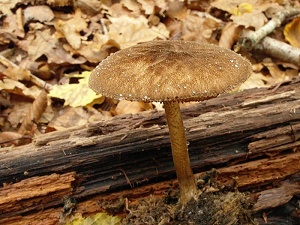| Pluteus umbrosus (Pers.:Fr.) P. Kumm. |
|
|
|
|
|
|
The cap is brown to pale-brown. The cap surface is not viscid nor sticky. The stem is white, without ring. The flesh is white, unchanging; the odour is unpleasant, of raw potatoes; its texture is fibrous. The gills are white then pink, free, crowded . The spore print is pink. This species is saprophytic. It grows on dead wood, mostly on beech chips, ash, elm, poplar. The fruiting period takes place from September to November.
Chemical tests : none. Distinctive features : veined cap; gills with dark brown edge; on dead wood or sawdust Pluteus umbrosus is rare and localised in the forest of Rambouillet, and is infrequent, more generally speaking . | ||
|
page updated on 14/01/18

